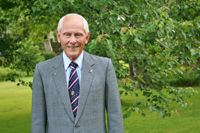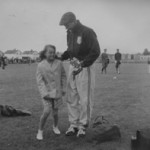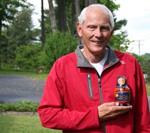On top of the world
Posted: September 12, 2012
Jack Daniels, PhD, is at the top of his profession, and literally, the top of the world. For more than 50 years, Dr. Daniels has dedicated his career to athletics and altitude training. Now, this two-time Olympic medalist, running coach, and author brings his expertise to the online classroom as an associate professor in ATSU’s Human Movement program.
Dr. Daniels’ interest in altitude training began in the ’60s while working for a German doctor. When they heard the 1968 Olympics were going to be held in Mexico City, an altitude of 7,300 feet, they researched how to prepare American, sea level athletes for racing at altitude. This led to preparing athletes at altitude for sea level events.
“One of the biggest advantages of altitude training is you learn to hurt,” says Dr. Daniels. “A normal workout feels more demanding than the same workout at sea level. Athletes learn to accept more discomfort, and when they go back to sea level, that new level of acceptance of discomfort is associated with a better performance.”
“Winning Olympic medals isn’t a big deal. What you win is not half as important as the journey on the way – the people you meet and the places you go.” — Dr. Daniels
Dr. Daniels, who has done much research on the topic, says altitude training is difficult to evaluate. Because many factors can contribute to an athlete’s performance improving after returning from altitude, it is difficult for research to prove that training at altitude is the answer. However, in his studies, he has never seen a subject’s performance decline.
While coaching at a New York college, Dr. Daniels took a female runner, whose best time in the 800-meter run was 2:39, to altitude for two weeks. He worked with her for two years, and she was doing well but wasn’t making major improvements. After returning from altitude, she began improving. Over the next two years she competed nationally, winning first place in many events. She even won the Penn Relays’ 10,000-meter race, running the last 800 meters in 2:31.
“If altitude provides a temporary benefit, then that girl should have only run well for a week or two, but she kept getting better without ever returning to altitude,” says Dr. Daniels. “She was the most improved runner I ever trained.”
Dr. Daniels knows runners who have actually moved to altitude because they believed so strongly in it, bringing their spouses and children along with them.
“If you’re going to make that kind of commitment, you’re probably going to train pretty seriously anyway,” says Dr. Daniels. “Maybe it doesn’t matter where you are.”

Dr. Daniels tests runners while riding on the front of a car in the 1960s.
Undeniably, Dr. Daniels has seen many athletes improve with some altitude training. For him, the question is, could those athletes have had just as much improvement if they hadn’t trained at altitude?
Kenyan runners have been winning Olympic races for years, and most of them train at altitude. Conversely, Dr. Daniels’ good friend and former lab assistant, Joan Benoit, never trained at altitude, and she was the first woman ever to win a gold medal in the women’s marathon at the 1984 Olympics.
“Plenty of successful people never train at altitude,” Dr. Daniels says. “I can’t say if they had done some altitude training they would have been even better. I think altitude training speeds up the process of an athlete reaching his or her highest potential.”
Regardless of the research, Dr. Daniels loves running and training at altitude and encourages others to try it. He says the most important thing about training at any altitude is to treat each athlete as an individual, following basic training principles. What works for one may not work for another.
Altitude training – athletic training at altitudes of approximately 5,000-8,000 feet above sea level – causes an athlete to breathe harder because the air pressure is lower, making it more difficult to deliver oxygen to the exercising muscles. The lack of oxygen in the blood often creates more red blood cells. The increase in red blood cells theoretically improves an athlete’s capacity to work, thus providing a competitive advantage.
“I had one runner who averaged 240 miles per week for one year,” says Dr. Daniels. “That’s over 30 miles a day! He held an American record for 30 years, but that doesn’t mean other people have to run that much to get the same results.”
While Dr. Daniels has focused much of his attention on coaching top athletes, he is also passionate about the health and fitness of the country and is concerned about the lack of physical education in today’s school system. He remains hopeful, though, because of the students he teaches at ATSU.
“I learn from my students every day,” says Dr. Daniels. “They are amazing. If we can get enough people like these students out there to work with and encourage people to be fit and healthy, we’re going to turn things around.”
He sees firsthand the disinterest in running among America’s youth.
“In this country, kids want to do other sports,” Dr. Daniels says. “They associate running with punishment.”
Dr. Daniels ironically began running because it was his worst event. He swam competitively and shot on the rifle team in college. While serving in the Army in Korea, he entered the Far East Triathlon Championships in Tokyo, Japan, which involved swimming, pistol shooting, and running.
“I had done shooting and swimming, so I thought, ‘This is natural,’” says Dr. Daniels. “Anybody can run. There’s no skill involved; it’s just a matter of training.”
After winning the triathlon, although placing last in the run, he began training for the modern pentathlon – an event comprising swimming, pistol shooting, running, fencing, and horseback riding. He learned to fence and ride horses, and ultimately took home an Olympic silver (Melbourne, 1956) and bronze (Rome, 1960) medal in the event. Despite his success, his weakness was still running.
“I wanted to learn how to run better,” Dr. Daniels says. “So I studied running and did my PhD dissertation on running. The more I learned about it, the more I wanted to coach it.”
Clearly he has been successful. Dubbed the “world’s best running coach” by Runner’s World magazine, Dr. Daniels takes his achievements in stride. Besides teaching online courses at ATSU, writing his biography, and of course, coaching runners, he is updating the third edition of his book, “Daniels’ Running Formula,” a scientifically-based training guide.
Additionally, he still conducts research. He finished his latest study this summer and has his sights set on his next project: bringing back his original altitude subjects. He tested 26 elite distance runners for his dissertation in 1968; in 1993, he retested all 26 of them. Now, 45 years later, he hopes to bring them back and run those tests for a third time.
“After 25 years, you wouldn’t believe how fit some of them were,” says Dr. Daniels. “Now their average age is 69, and I can’t imagine a more interesting longitudinal study on the physiology of elite athletes.”
With one accomplishment after another, Dr. Daniels has certainly been enjoying his journey, and he continues to push himself – all the way to the top.
Reminiscing: Dr. Daniels shares his greatest memories
 On July 4, 1957, Dr. Daniels became the first foreigner to win the Swedish pentathlon championships. As he went forward to receive his award, a 10-year-old girl kindly gave him flowers.
On July 4, 1957, Dr. Daniels became the first foreigner to win the Swedish pentathlon championships. As he went forward to receive his award, a 10-year-old girl kindly gave him flowers.
“They didn’t give her flowers to give to me; she picked them herself,” Dr. Daniels says. “I’ll never forget that. My picture with her is my favorite picture of all time.”
Daniels had a Russian friend named Igor during the Cold War – a time when it was controversial to have a Russian friend. Igor, who happened to be the world’s greatest athlete at the time, raced against Dr. Daniels every year for five years, and the two became good friends. One year, Igor brought him a wooden cluster doll as a gift from his wife.
greatest athlete at the time, raced against Dr. Daniels every year for five years, and the two became good friends. One year, Igor brought him a wooden cluster doll as a gift from his wife.
“He must have talked about me to his wife because I never met her,” says Dr. Daniels. “I certainly talked about him to my friends. For her to have never met me and give me a gift, you can’t top that.”